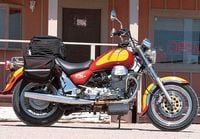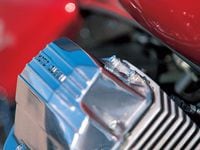There is more than one way to draw a V-twin. Moto Guzzi has always put its big V-twins across the frame so the air-cooled cylinders jut out into wind and the drivetrain doesn’t have to turn a corner to mesh with the final drive shaft. The 1064cc engine’s 90-degree V-angle allows the engine to operate smoothly without balancers or rubber mounts. Despite a general upgrade this year, the V11 still operates its two overhead valves per cylinder with pushrods. However, electronic fuel injection is now standard. Five speeds and a dry clutch direct power to the drive shaft.
Though the chassis appears unexceptional, the Guzzi actually offers the most advanced suspension here. The stout 45mm Marzocchi fork may not look fashionably fat, but it offers adjustments for damping. It also has a hydraulic steering damper. Dual WP damper units in the rear also permit you to tailor the ride to your requirements. Triple, four-piston caliper brakes stop special wire-spoke wheels with tubeless Pirelli tires. Though recently used on some other bikes, integrated braking—where the brake pedal operates both front and rear brakes—was pioneered by Guzzi decades ago. Integrated brakes are used on this machine, too.
The V11 EV has a unique combination of styling influences. With the shortest wheelbase and highest seat here, it doesn’t subscribe to the long, low look. The tank holds five gallons without looking fat. On the other hand, it has floorboards and a heel-toe shifter, though there is a mini footpeg on the right to help you operate the brake more easily. The saddle is a one-piece design with a small passenger backrest. It also has the only luggage rack and centerstand in this collection.
For the rider to whom “rugged individualist” means more than buying the same machine the guy down the block has, the Guzzi, at $11,690, is truly singular.
This article was originally published in the August 1998 issue of Motorcycle Cruiser.


/cloudfront-us-east-1.images.arcpublishing.com/octane/ZFLEN5GEBJCXTJ72JLUO3QGHMQ.jpg)
/cloudfront-us-east-1.images.arcpublishing.com/octane/4RZQRGUTA5C2DMOEDGURJB4KRI.jpg)
/cloudfront-us-east-1.images.arcpublishing.com/octane/YJODDXEL2ZB5TENKPPN4BEYJAE.jpg)
/cloudfront-us-east-1.images.arcpublishing.com/octane/QEQQUZYNJFAIJB4DZFVFSNTCQ4.jpg)
/cloudfront-us-east-1.images.arcpublishing.com/octane/4OXL3PXHL5H3FAC7T5TCDX3S34.jpg)
/cloudfront-us-east-1.images.arcpublishing.com/octane/SUBBIQYDUNGJVHLA5TNHHRE3P4.jpg)
/cloudfront-us-east-1.images.arcpublishing.com/octane/4HLQB4W255HQ5GYOKOZNX7XKQA.jpg)
/cloudfront-us-east-1.images.arcpublishing.com/octane/F4VV6HPB55GIJABTHTQ2TM3ZQQ.jpg)
/cloudfront-us-east-1.images.arcpublishing.com/octane/DK7E3BPVEZAMXDKGXO4FY4JKA4.jpg)
/cloudfront-us-east-1.images.arcpublishing.com/octane/NAFNT7QSPNHSDHQ2SNCETHCRLI.jpg)
/cloudfront-us-east-1.images.arcpublishing.com/octane/VR253G637RGAHMEOM335EG2JMQ.jpg)
/cloudfront-us-east-1.images.arcpublishing.com/octane/SADSHCVUANAKVOZNPBEZW3AZNA.jpg)
/cloudfront-us-east-1.images.arcpublishing.com/octane/KFBYBE2JFVDGNFQU45I6ARG5WA.jpg)
/cloudfront-us-east-1.images.arcpublishing.com/octane/ZZNO6KMQ7RCILM3WVEPFUW44YI.jpg)
/cloudfront-us-east-1.images.arcpublishing.com/octane/ARDOSF3OGVCYTAPOKK66XYUEPY.jpg)
/cloudfront-us-east-1.images.arcpublishing.com/octane/VDADHHBS4NDN3LPASLBEPMN4GE.jpg)
/cloudfront-us-east-1.images.arcpublishing.com/octane/E3IGAU34MBBC3LIY6BEI5NVFKU.jpg)
/cloudfront-us-east-1.images.arcpublishing.com/octane/E7PLK4SZEFHXRNZVH2Z7GLZ2BY.jpg)
/cloudfront-us-east-1.images.arcpublishing.com/octane/FPHQ6O7HXFARVJ3L2ZYJIB4NBM.jpg)
/cloudfront-us-east-1.images.arcpublishing.com/octane/4XQZKUS5UJGY3IEBVERSNGGJ3U.jpg)
/cloudfront-us-east-1.images.arcpublishing.com/octane/A37VPL2PPRE3DGPBZI4V6N2IHE.jpg)
/cloudfront-us-east-1.images.arcpublishing.com/octane/JAF4HTUZ45GJBGM2MBOKB67DDE.jpg)
/cloudfront-us-east-1.images.arcpublishing.com/octane/JJ7MLEP34VBNPIJJKTZR472JOA.jpg)
/cloudfront-us-east-1.images.arcpublishing.com/octane/CC5ECSX765A7ZEKRA2QB363BME.jpg)